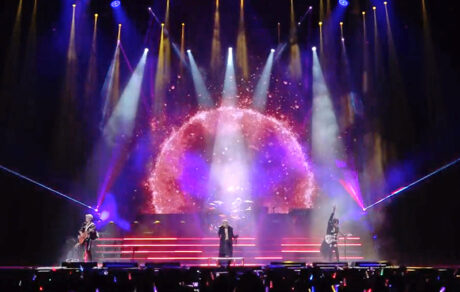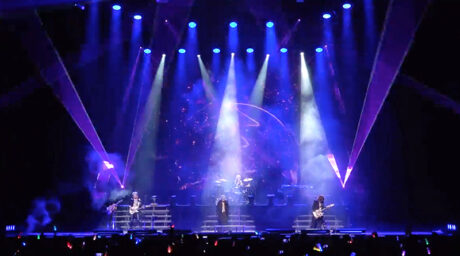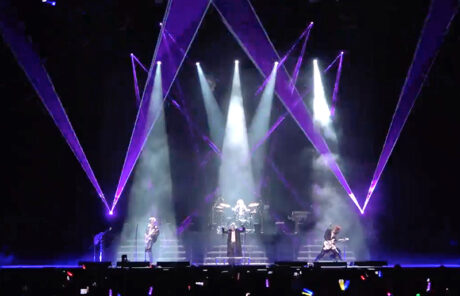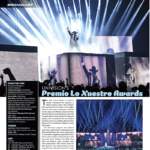
The Last Rockstars (TLRS), a Japanese rock supergroup formed in late 2022, consists of Yoshiki and Sugizo, both from X Japan; Hyde came from L’Arc-en-Ciel, and Miyavi is formerly of Dué le quartz. In early 2023, the new act played a mini tour of three cities—Tokyo, New York, and Los Angeles, all of which sold-out almost immediately. The group’s leader, Yoshiki, stated that the mission of the group was to “aim at the international market beyond Japan” and to “preserve the spirit of rock music.”
Designer Peter Morse has designed X Japan’s shows for eight years and was brought onboard to production design the TLRS mini inaugural tour. Adding an additional twist to the project was a global livestream. For their last show on February 10 at LA’s Hollywood Palladium, The Last Rockstars partnered with Live Nation and Veeps for a global livestream of the sold-out concert broadcast to more than 50 countries. The concert was also shown live in over 100 movie theaters in Japan. The video shoot and livestream of the performance was directed by Kevin Garcia, Principal of MixOne Cinema, LLC. PLSN caught up with Garcia and Morse to learn more about how they realized this live concert and streaming performance.

Video Direction
For Garcia’s scope of work, he comments, “Basically, I handled the I-Mag and the stream for digital platform Veeps. Then we also sent another signal to LiveU that streamed to movie theaters around Japan, which was crazy because that was a new one for me.” Garcia, who has directed a lot of shoots at the Palladium, found it interesting that The Last Rockstars brought an arena-scale production into a theater. “That was a tricky thing to work around just because they were using similar production elements to their show in New York, [at the Hammerstein Ballroom] which was a bigger venue, and their shows in Japan at Ariake Arena and Tokyo Garden Theater, which are massive. We had pyro, cryo, confetti, and a lot of production all to work around within a small theater; on top of fitting in my 10 cameras. As well as covering I-Mag at the same time as the streaming, which traditionally, those are separate worlds.”

For his shoots, including capturing this performance, Garcia uses a full Blackmagic Design (BMD) workflow, explaining “Everything I have, from top to bottom, is all Blackmagic workflow. The Blackmagic URSA Broadcast G2 are my A cams. I then had a couple Pocket Cinema 6K Pros and 4K Pros as needed, using those in place of where people would normally traditionally use a Marshall camera. Those are my main cameras. Their dynamic range makes it where when the pyro goes off, I can still see, and when it’s dark I can still kind of see. I’ve used Blackmagic Design products for a while; the first one I bought was a URSA Mini Pro 4.6. It was the only one they had at that time.”

Everything Just Connects and Talks
When asked what he appreciates about the Blackmagic Design products, Garcia says, “I like that it’s just so easy. Everything just connects and talks. I can control it all very easily. Multi-cam is my main thing at this point, and everything just talks and works. I run fiber and then I convert it back to SDI or HDMI to control all the cameras. Everything is all one ecosystem. It’s like Apple. Everything just works together. At my house, I have Apple TV and I have an iPhone. I can walk around the house and control my Apple TV from my phone. It’s the same thing just in broadcast world, which is super convenient to have. I’ve done multi-cam shoots where it’s not my cameras. It just never works when you turn everything on the first time. It’s always like, ‘Oh, hold on, change this. Oh, let’s change that.’ With Blackmagic, we turn it on and everything’s just there. It’s been very reliable.”
For his switcher, Garcia used the BMD ATEM 2 M/E Constellation HD, with 20 inputs and 12 outputs. “For Last Rockstars, I had to use every single output for the first time,” notes Garcia, “because the I-Mag took four ISOs; the movie theater needed two lines; and the stream needed two separate lines. The LD needed a line, the audio engineer, broadcast engineer, and I all needed a line. Every single outlet used.”
Garcia relied heavily on the rest of his team for this shoot and gives a big shout out to Assistant Director, Kevin Lieberman, and Director of Photography, Gabriel Gely for their hard work. He also enjoyed working with The Last Rockstars team. “They were an absolute great camp to work with. Super polite and professional from top to bottom in every element. I had a meeting with Yoshiki prior to the show, going over his expectations and goals for the show, and it was nothing but just kindness. They’re a great group to work with, which is not always the case in the music industry. This was a good experience all around.”

Rockstar Lighting
Designer Morse recalls, “I got a call from Marty Hom saying ‘Yoshiki wants you on board along with Troy Eckerman.’ I was in. I designed the set and lights, which had to adapt to a variety of venue sizes. In Japan, we played two nights at the Ariake Arena and then two nights at the beautiful Garden Theater. All the shows sold out. Then we played the Hammerstein Ballroom in New York and the Hollywood Palladium; again all sold-out shows.” Eckerman, who also said yes, served as Programmer for The Last Rockstars mini tour.
Big One Lighting provided the lighting equipment for the Japan shows and PRG handled suppling the gear for the NYC and LA shows. For Morse’s key equipment, he used 16 Martin MAC Viper AirFX and 17 MAC Viper Profiles along with 48 Claypaky Sharpys. “We used the FollowMe system for our remote followspots paired with Robe BMFL Spots,” Morse explains. “For my floor lighting, I went with more AirFX, Vipers, and Sharpys along with GLP impression X4s and a lot of [Martin] VDO Sceptron 40s.” His plot also included Robe Tarrantulas, GLP JDC1 Strobes, CHAUVET Nexus 4×4 Wash Panels, and there was also a 3’ diameter mirror ball.

A Clear Stage
For the show, Yoshiki was on platform playing drums and piano with the other three group members performing down on the apron. Morse’s set design had a stair unit going up to a 4’-high platform that was 25’ wide and 12’ deep for Yoshiki. “The riser had his drum kit center and his grand piano stage left,” says Morse. “The surface of the platform was all plexiglass, so we did a lot of uplighting through there onto the drums and piano.”
After programming in previz, with not a lot of rehearsal time, Morse felt prepared, and he and Eckerman adjusted things as they went along. “A lot of it was punting, because the band was punting too,” points out Morse. “I did a lot of rear back lighting (via FollowMe) because the guys were moving all over the place. Also, I had followspots for each of them, as well as side lighting and shin kicks, which I love using so they were showing up as a rock band should; not necessarily key lit, but in color and highlighted one way or another.”
Eckerman ran the show manually for the first night or two until he and Morse were sure they were locked in. “Troy winged a lot of stuff, and I concentrated on the spot cues and note taking to fix things. I have to say, Troy’s the man. It is great working with him.” Morse also gives a shoutout to Caleb Eckerman, Troy’s son, who helped prepare for the transition from Japan. “Caleb helped me with a lot of the cloning between shows as we were switching gear into the U.S. We didn’t have much time to clone as we loaded-in, so he did it for us offsite. He was a big help. The shows went off really quite well once we had a format down.”
There are no announced plans for what the future holds for The Last Rockstars, but looking at the overwhelming international fan response, it’s safe to say that we’ve not heard the last from this Japanese supergroup—and it will be interesting to see what Morse designs next.


